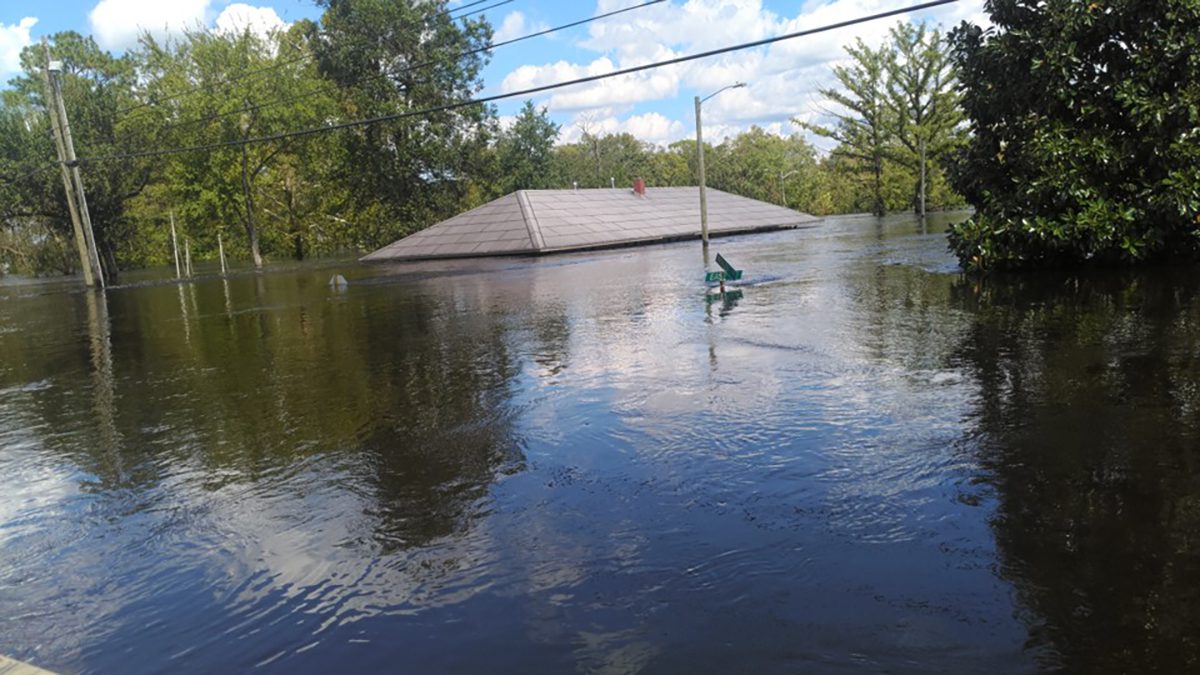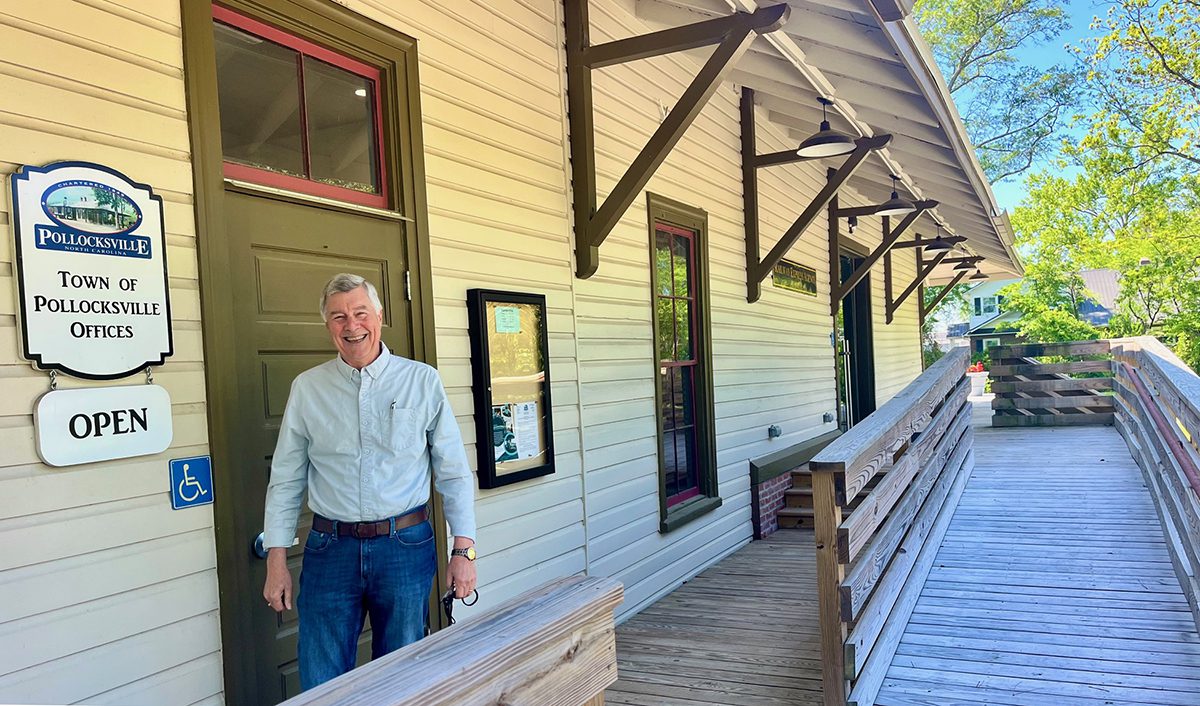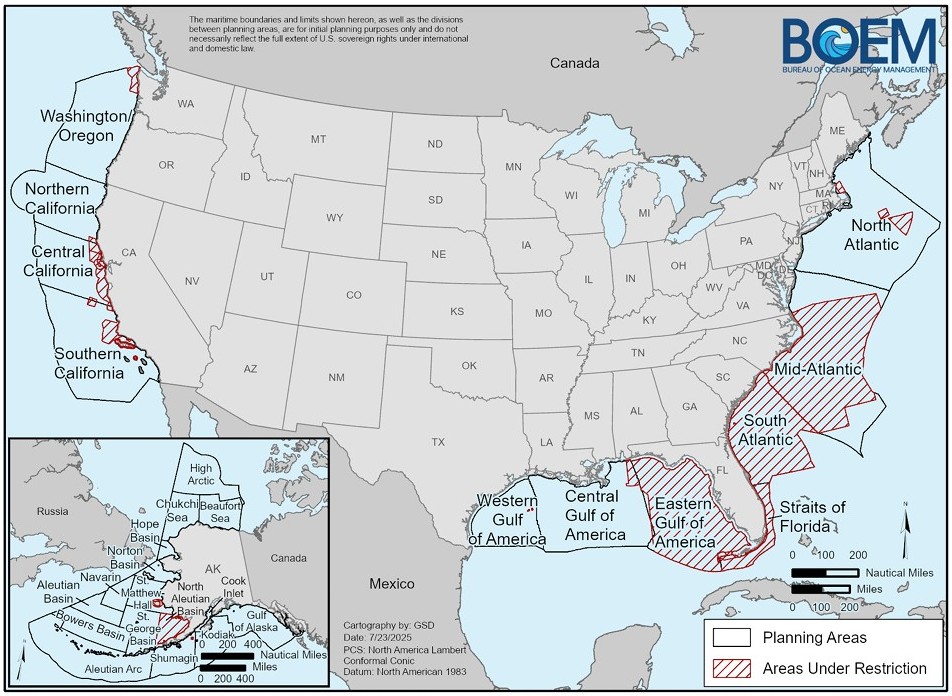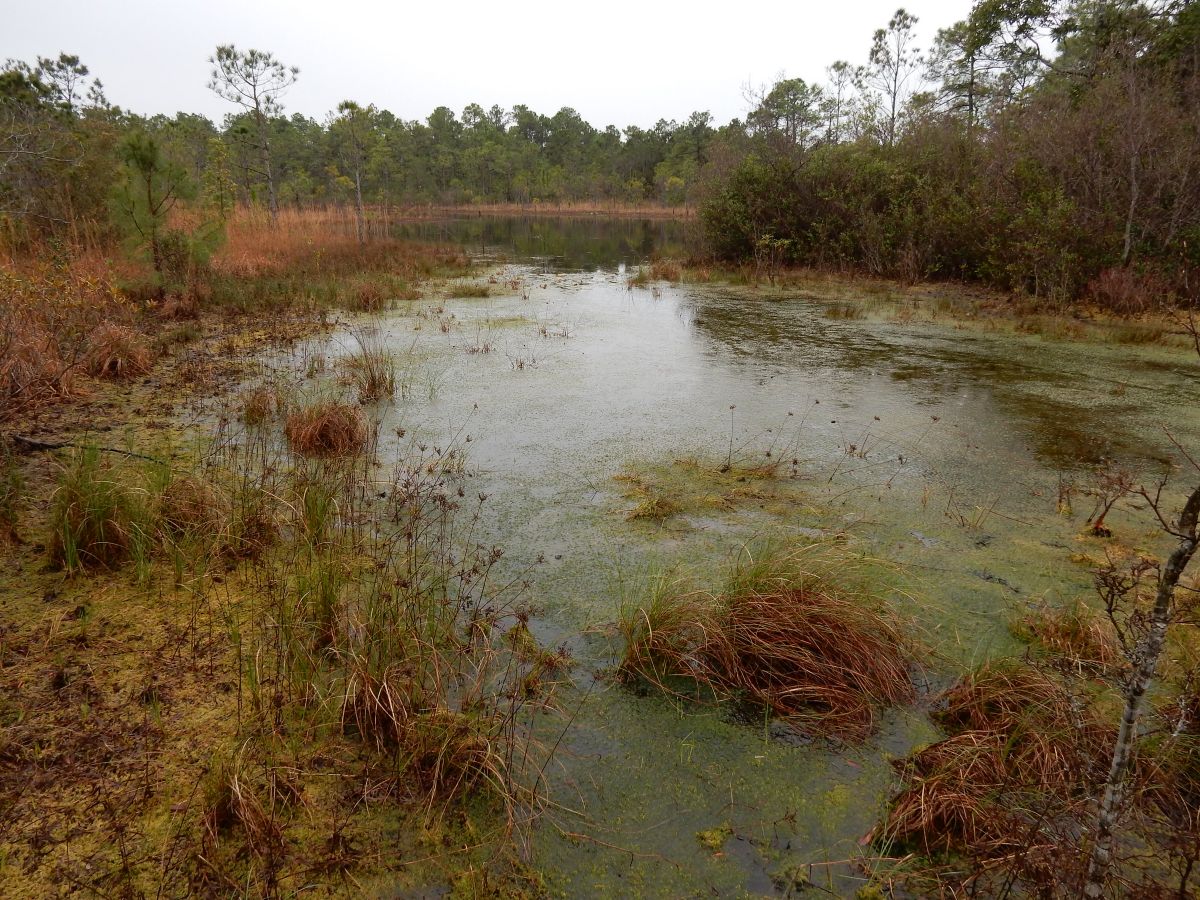
This is the first in a series of stories about the effects federal budget and staff cuts and the cancellations of programs and services are having in coastal North Carolina.
POLLOCKSVILLE – Jay Bender is rightfully proud of his town hall. Lovingly restored when it was moved to higher ground a few years ago, the old train depot has come to symbolize the grit of this little river town that a hurricane once tried to drown and its government in far-off Washington now has abandoned.
Supporter Spotlight
The mayor for 42 continuous years – a record in North Carolina – Bender fashioned his office to look like one that the stationmaster might have used when the depot was built in 1893. An antique rolltop desk anchors the room, accented by sturdy wooden chairs for visitors and framed railroad maps on the walls.
He led me to the handsome town council chambers with its wide-beamed oak floor and huge, sliding, wooden cargo doors that bear names and other graffiti that people scrawled during the building’s lifetime. “All of this was under water,” explained Bender. “We lost everything. We lost our records. We lost our computers. Everything.”
Related: North Carolina among most successful states for BRIC awards
The depot, which even then served as town hall, was a few blocks away, down on the banks of the Trent River, a pretty, usually placid stream that languidly flows northeast a dozen or so miles to its confluence with the Neuse River in New Bern. In these parts it’s known primarily for its catfish and largemouth bass. It was the little town’s biggest attraction.
Until it became the source of its destruction.
Supporter Spotlight
That would have been during those three, grim days in September 2018 when Hurricane Florence dumped more than more 30 inches of rain and unleased a biblical deluge. The river had overflowed its banks before, of course – back in 1999 after Hurricane Floyd, for instance – but never like this. Some experts would later speculate that the Trent hadn’t flooded that badly in maybe 1,000 years. It rose more than 25 feet, covering much of Pollocksville to its rooftops. Most of its 300 or so residents had to be evacuated. More than 80% of its buildings were destroyed or damaged, including every town commissioner’s home.

Bender, living in his grandfather’s old place on high ground, was spared. That’s where they ran the town until the river receded and the power was restored 11 days later.
The slow recovery then began.
Aided by state and federal grants, the town moved and refurbished the waterlogged old depot in 2021 and began getting pieces of its sewer and water systems out of the floodplain. Owners raised some buildings, and the town gussied up U.S. Highway 17, its main road, with a bike path, planters and banners.
The place was starting to look almost normal again, and Bender was feeling optimistic about his town’s revival until the Trump regime in Washington suddenly and without warning pulled the rug out from under him.
Killed without warning
The Federal Emergency Management Agency announced about a month ago that it was cancelling its major grant program that provided seed money to communities that wanted to be better prepared for the next flood or weather catastrophe. FEMA didn’t contact Pollocksville or the 67 other communities in the state that were awarded grants but had not yet received any money. Neither did it notify the N.C. Division of Emergency Management, which administers the grants, or the media. The agency made the surprise announcement on one of its websites after 5 p.m. on a Friday, presumably to attract the least amount of attention.
Bender didn’t find out about the cancellation until the following week. It was the first time a federal grant program had been killed in midstream.
It would be another 12 days before FEMA clarified that only grant projects that had been completed would be totally funded. Those that have started might receive partial funding. Everything else was dead. In North Carolina, that meant almost $186 million in projects intended to help communities ward off weather catastrophes and save lives would have to be shelved unless the recipients could come up with the money elsewhere. That total includes about $81 million in the state’s 20 coastal counties, including $1.1 million for Pollocksville to raise six commercial buildings to revive its downtown.
“Losing the grant is very disappointing,” said Bender, whose town operates on an annual $600,000 budget. “It would have funded the next step in our long-range plan. Replacing the grant money will be difficult.”
The Building Resilient Infrastructure and Communities grants, known as BRIC, was the federal government’s showcase program to help communities help themselves by funding projects to lessen and prevent storm damage. It committed almost $5 billion to communities across the country since it was approved by Congress with bipartisan support and signed by Donald Trump in 2018 during his first term. Local governments had planned to use the money to help raise buildings and roads, relocate vulnerable sewer pump stations, control flooding, strengthen building codes and on similar projects to reduce the damage of future storms. The program was so popular that last year FEMA had to reject nearly 2,000 applicants because it didn’t have enough money to go around.

About $1 billion was allocated to the program as part of the Infrastructure Investment and Jobs Act in 2021. Under President Biden, the BRIC grants were key parts of the government’s efforts to address climate change, and a special emphasis was placed on helping Black and other historically underserved communities. It was those directives that likely put BRIC on the regime’s hit list.
‘Wasteful,’ ‘political,’ fearful
An unnamed FEMA spokesperson said in the April announcement that the agency now considers BRIC to be “wasteful” and “political.” I called FEMA’s “news desk” at its regional office in Atlanta several times to get some examples. Each call disappeared into the ether because the number listed on the agency’s regional website didn’t even generate a dial tone. I sent an email to the address listed on the site. It remains unanswered. As do the emails and phone message I sent to the state’s two Republican senators, Thom Tillis and Ted Budd, asking for their reactions.
Many county and town officials also didn’t return emails and phone calls. They watched the bullying of the country’s biggest universities and law firms and heard the threats about withholding federal funds to public schools and museums. They apparently got the message. They would need FEMA someday, and all depended on federal funding for something. Bender understands his counterparts’ desire to remain under the radar. He’s relying partially on federal money to upgrade his water and sewer plants. “We lose this grant and we’re out maybe $20,000,” he said. “But I can’t build half a sewer plant.”
Anna Weber, however, needed no coaxing. She’s a policy analyst for the National Resources Defense Council and helps communities prepare for the violence of an unstable climate. She has a hard time understanding how spending money to prevent death and damage from future storms can suddenly be considered wasteful.
“In fact, investing in adaptation and resiliency against climate change is one of the least wasteful things we can do,“ she said. “It’s actually one of the best investments in preventing future local damage and loss of life from storms.”
She noted that studies have consistently shown that every dollar invested on projects to prevent storm damage results in at least $6 in savings when the pieces later have to be picked up and put back together.
BRIC also seemed to dovetail with the regime’s desire to require states to pay more for cleanup and reconstruction costs after a disaster, Weber said. The grants pay 75% of project costs. The applicant is responsible for the remainder. “These were communities that were doing this right,” she said. “The federal government wanted communities to step up and take some responsibility. These communities did step up and do what the government asked, and now the rug is being pulled out from under them.”
The charge that the grants were doled out as political favors by the Biden administration makes little sense in North Carolina, which Trump carried handily in all three of his elections. The 22 counties, which include the state’s most populous, that Biden won in 2020 received only about a quarter of the grant money, while the 20 coastal counties, many of which Trump won with 60-70% of the vote, received almost 45%.
Jessica Whitehead was North Carolina’s first chief resilience officer and helped evaluate the state’s first BRIC applications in 2020. She’s now director of the Institute for Coastal Adaptation and Resilience at Old Dominion University.
“Politics?” she said. “It never came up.”
No one asked Bender about his politics when the town applied for its BRIC grant.
“This had nothing to do with politics,” he said, “and I don’t know how you can consider it wasteful. This is all about trying to get our town back to normal.”







